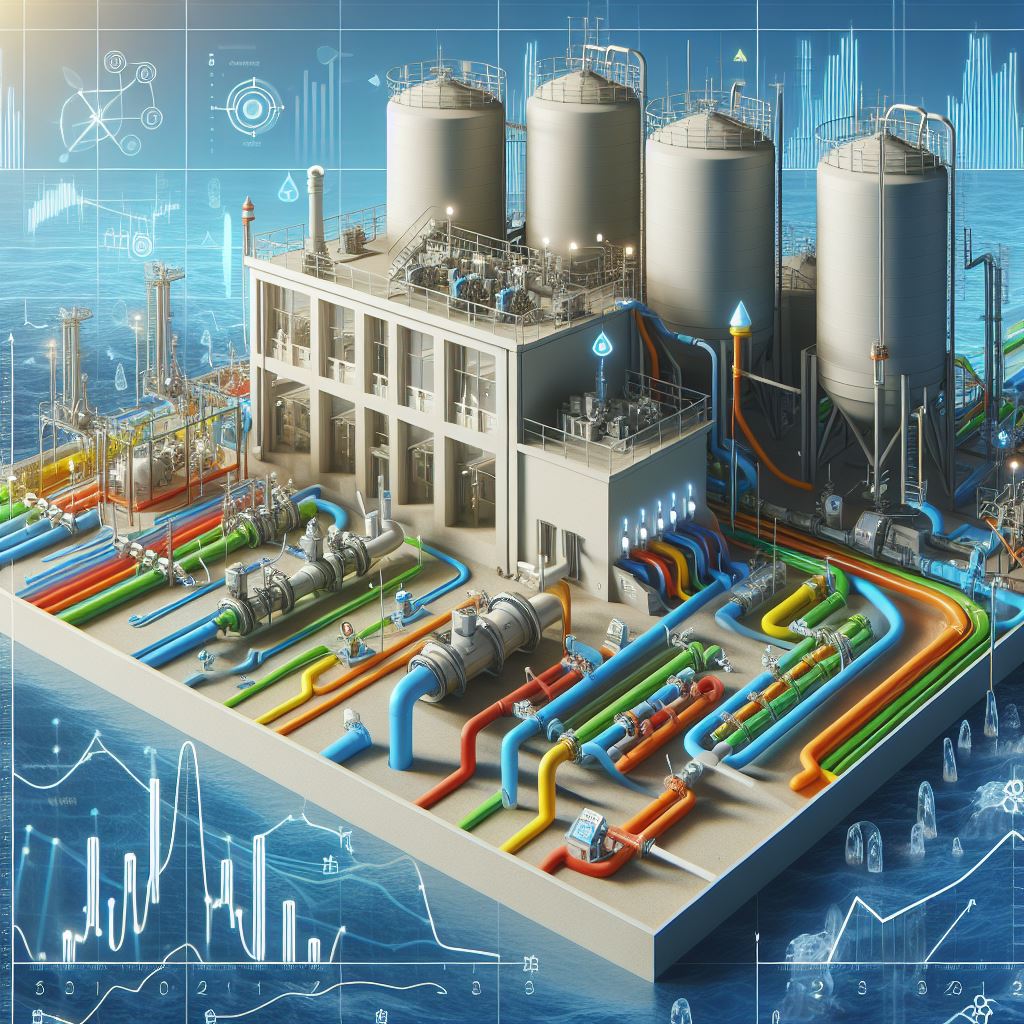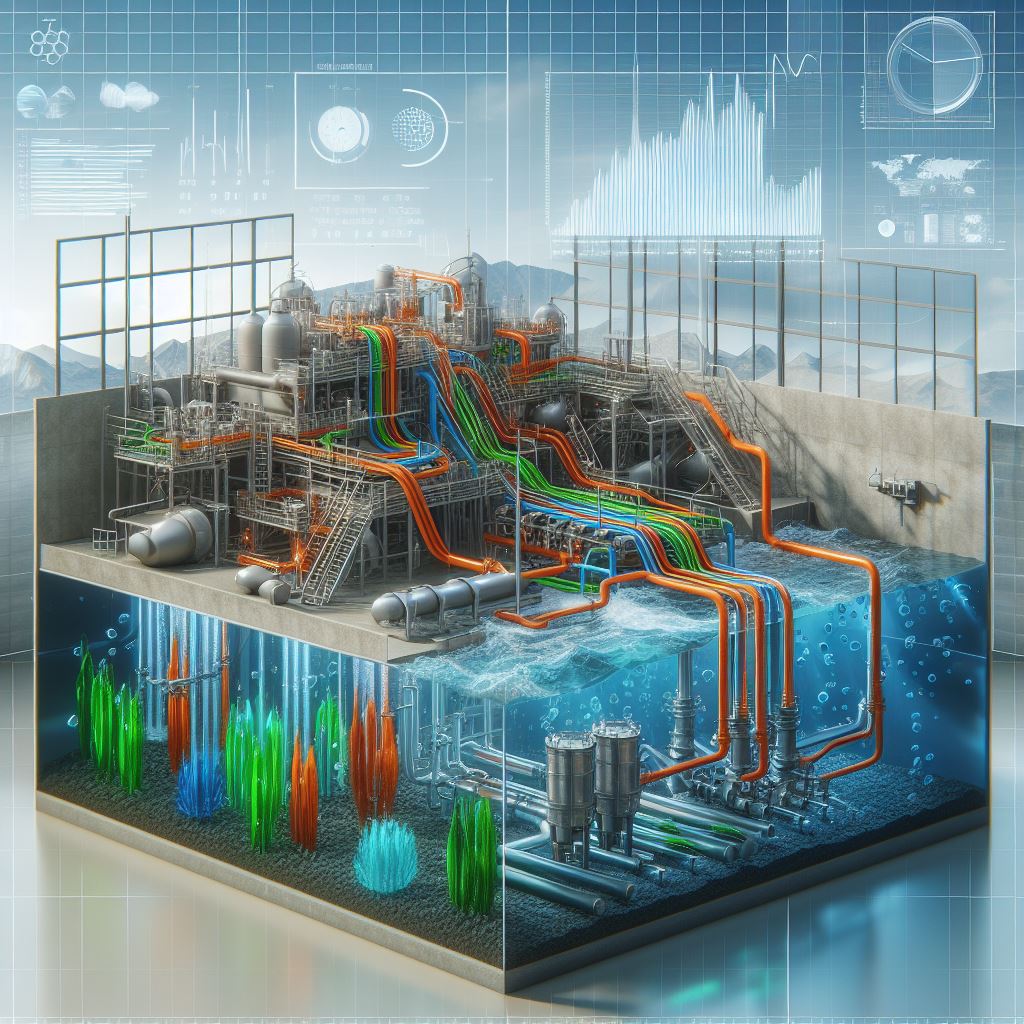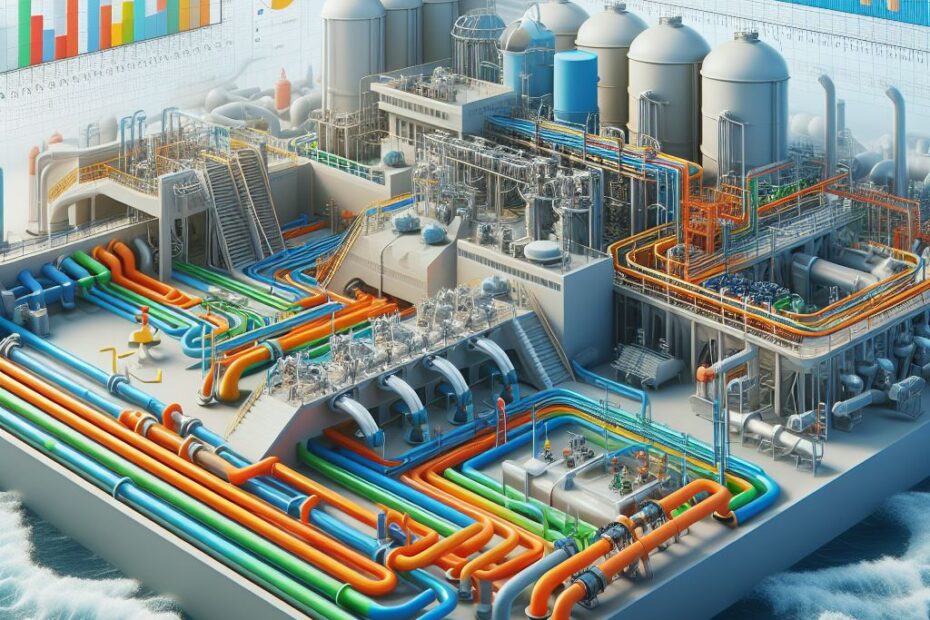I. Introduction of Effluent Treatment
Effluent, in its simplest form, refers to wastewater or liquid waste discharged from industrial, commercial, or domestic activities. It encompasses a range of substances, from chemicals and toxins to organic matter, which can pose significant risks to the environment if not properly managed.
Effluent treatment stands as a critical process in safeguarding our ecosystems and public health. Its significance lies in mitigating the adverse effects of pollution on water bodies, soil, and air. By treating effluent before its release into the environment, we aim to minimize contamination and preserve the natural balance of our surroundings.
Importance of Effluent Treatment in Environmental Conservation
Effluent treatment serves as a frontline defense against environmental degradation. Unchecked discharge of untreated effluent can lead to a plethora of harmful consequences:
- Water Contamination: Untreated effluent contains various pollutants such as heavy metals, pathogens, and organic compounds, which can contaminate water sources and jeopardize aquatic life.
- Soil Degradation: When effluent seeps into the soil, it can disrupt its structure, fertility, and composition, rendering it unsuitable for agriculture and other essential functions.
- Air Pollution: Certain volatile compounds present in effluent can evaporate into the atmosphere, contributing to air pollution and posing risks to human health.
Effluent treatment acts as a crucial mechanism for reducing these environmental risks. Through processes like filtration, sedimentation, and chemical treatment, harmful contaminants are removed or neutralized, ensuring that discharged water meets regulatory standards and poses minimal harm to the environment.
Furthermore, effluent treatment aligns with broader principles of environmental conservation and sustainability. By investing in efficient treatment systems, industries and communities demonstrate their commitment to responsible stewardship of natural resources and protection of biodiversity.
In essence, effluent treatment is not just a regulatory requirement but a moral imperative. It reflects our collective responsibility to safeguard the planet for current and future generations, ensuring that our actions today do not compromise the well-being of tomorrow.
Effluent treatment, therefore, stands as a beacon of hope in our efforts to maintain ecological balance and preserve the beauty and integrity of our natural world.
II. Understanding Effluent

Effluent, in its simplest terms, is the wastewater or liquid waste discharged from industrial, commercial, or domestic activities. It encompasses a wide array of substances, ranging from chemicals and solvents to organic matter and heavy metals. Understanding effluent involves recognizing its composition, its sources across different industries, and the profound impact of untreated effluent on both the environment and human health.
What Constitutes Effluent?
Effluent is a complex mixture that can vary greatly depending on its source. In industrial settings, effluent often contains pollutants such as:
- Chemicals: Including acids, alkalis, solvents, and heavy metals like lead, mercury, and cadmium.
- Organic Matter: Such as oils, fats, and biological materials from food processing or agricultural activities.
- Suspended Solids: Particulate matter, sediment, and other solid substances.
- Nutrients: Like nitrogen and phosphorus, which can contribute to eutrophication in water bodies.
In domestic settings, effluent primarily consists of wastewater from households, containing sewage, detergents, and personal care products.
Sources of Effluent in Various Industries
Effluent is generated across a spectrum of industries, each contributing its own unique blend of contaminants:
- Manufacturing Industries: Chemical manufacturing, textile production, metalworking, and pharmaceuticals are among the sectors that produce significant volumes of effluent laden with various chemicals and by-products.
- Food and Beverage Processing: Effluent from food processing plants contains organic matter, grease, and nutrients from cleaning processes and food waste.
- Mining and Extractive Industries: Mining activities can release heavy metals, sediments, and toxic substances into waterways, contaminating effluent.
- Agriculture: Runoff from agricultural lands can carry pesticides, fertilizers, and animal waste, contributing to effluent pollution in rivers and streams.
Impact of Untreated Effluent on the Environment and Human Health
The discharge of untreated effluent poses severe risks to both the environment and human well-being:
- Water Pollution: Effluent discharged into water bodies can degrade water quality, disrupt aquatic ecosystems, and harm aquatic life through oxygen depletion and chemical toxicity.
- Soil Contamination: Effluent that seeps into the soil can contaminate groundwater reserves, affecting drinking water sources and agricultural lands.
- Public Health Risks: Exposure to untreated effluent can lead to a range of health issues, including gastrointestinal illnesses, skin infections, and respiratory problems due to the presence of pathogens and toxic substances.
- Ecosystem Degradation: Effluent pollution can disrupt the balance of ecosystems, leading to declines in biodiversity, loss of habitat, and negative impacts on fisheries and wildlife populations.
In summary, understanding effluent involves recognizing its diverse composition, identifying its sources across various industries, and acknowledging the far-reaching consequences of untreated effluent on the environment and human health.
III. The Effluent Treatment Process
Effluent treatment is no walk in the park; it’s a meticulous dance between science and nature, ensuring that what we release into the world doesn’t leave a toxic mark. Let’s dive into the symphony of the effluent treatment process.
Overview of the Effluent Treatment Process
Imagine it as a purification ritual for wastewater. The goal? To cleanse it from industrial sins, leaving behind water that nature can embrace. The process is a multi-step journey that demands precision and care.
Key Components and Stages Involved
1. Screening and Pre-treatment: Before the real work begins, effluent undergoes a preliminary screening to remove large debris. It’s like sorting out the big chunks before diving into the nitty-gritty. Pre-treatment then kicks in, addressing substances that could wreak havoc on downstream processes.
2. Primary Treatment – Physical Cleansing: Picture a settling pond, where the heavier, solid particles take a graceful dive to the bottom. This is primary treatment – a physical ballet where gravity does the work, and pollutants find their way out. Sedimentation tanks and clarifiers play a starring role, letting the unwanted elements settle and be swept away.
3. Secondary Treatment – Chemical Transformation: Now, let’s add a touch of chemistry to the mix. Secondary treatment focuses on breaking down dissolved and suspended pollutants. Microorganisms step into the limelight here. They munch on organic matter, transforming it into something less harmful. Aeration tanks provide the stage for this microbial feast, ensuring the water is left purer after this biological tango.
4. Tertiary Treatment – Final Polish: For the grand finale, tertiary treatment steps in. This is the polishing act, where any remaining impurities face the music. Filtration, chemical disinfection, and advanced processes like UV treatment add the final strokes to ensure the water meets the highest standards before it’s sent back into the world.
Role of Physical, Chemical, and Biological Treatments
1. Physical Treatment: It’s the first handshake in the effluent treatment process. Physical treatments rely on the laws of physics to separate impurities. Gravity, centrifugation, and filtration become the unsung heroes, orchestrating the removal of larger particles and letting the water breathe.
2. Chemical Treatment: Now, let’s bring in the alchemists. Chemical treatments use various substances to induce changes in the composition of pollutants. Coagulants and flocculants join the party, causing impurities to clump together for easier removal. It’s a bit like using magic spells to turn pollutants into harmless companions for the journey.
3. Biological Treatment: Nature has its own cleanup crew, and we put them to work in the biological treatment stage. Microorganisms, the unsung heroes of this environmental epic, break down complex organic matter into simpler, less harmful forms. It’s like a tiny army of microscopic janitors working tirelessly to restore the water to its natural, pristine state.
In this elaborate dance of physical, chemical, and biological treatments, effluent treatment emerges as a crucial act of environmental responsibility. It transforms wastewater from an industrial castoff to a rejuvenated resource, ready to rejoin the ecological cycle. The process is a testament to our ability to collaborate with nature, ensuring that our industrial footsteps leave the lightest mark on the Earth.
IV. Technologies Used in Effluent Treatment

Effluent treatment relies on a spectrum of technologies to effectively mitigate environmental impact and ensure regulatory compliance. Among these, sedimentation, filtration, and oxidation stand as stalwarts, while membrane filtration and advanced oxidation processes represent cutting-edge innovations.
Sedimentation:
Sedimentation, a fundamental process in effluent treatment, harnesses gravity to separate suspended solids from liquid effluent. Through settling basins or clarifiers, heavy particles settle to the bottom while clarified water is skimmed off the top. This simple yet effective method is widely employed in municipal wastewater treatment and certain industrial applications. However, it may not suffice for effluents with finer particles or complex compositions.
Filtration:
Filtration mechanisms play a pivotal role in refining effluent quality by removing suspended solids, colloidal particles, and microorganisms. Common filtration methods include sand filters, activated carbon filters, and multimedia filters. Sand filters trap particles as water percolates through layers of sand, while activated carbon adsorbs organic contaminants. Multimedia filters combine various media like sand, anthracite, and garnet for enhanced filtration efficiency. These techniques are versatile and adaptable across diverse effluent compositions and treatment requirements.
Oxidation:
Oxidation processes are instrumental in degrading organic pollutants and disinfecting effluent prior to discharge. Chlorination, ozonation, and UV irradiation are prevalent oxidation methods. Chlorination involves the addition of chlorine-based compounds to effluent, effectively killing pathogens and oxidizing organic compounds. Ozonation employs ozone gas to oxidize contaminants, breaking down complex molecules into simpler, less harmful byproducts. UV irradiation utilizes ultraviolet light to disrupt cellular structures of microorganisms, rendering them inactive. While effective, oxidation processes necessitate careful consideration of disinfection byproducts and environmental impacts.
Membrane Filtration:
Membrane filtration represents a paradigm shift in effluent treatment, offering unparalleled precision and efficiency in separating contaminants from water. Yeah, Membrane technologies such as reverse osmosis (RO), ultrafiltration (UF), and nanofiltration (NF) utilize semi-permeable membranes to selectively remove particles, ions, and pathogens based on size and molecular weight. RO membranes excel in desalination and brine treatment, while UF membranes are adept at removing colloidal solids and bacteria. NF membranes strike a balance between permeate quality and operational cost, making them ideal for various effluent streams. Despite their efficacy, membrane filtration systems require meticulous maintenance and operational oversight to ensure optimal performance.
Advanced Oxidation Processes (AOPs):
Advanced oxidation processes represent the vanguard of effluent treatment, leveraging highly reactive oxidants to degrade recalcitrant pollutants. Techniques like Fenton’s reagent, photocatalysis, and sonochemistry harness chemical, photochemical, and acoustic energy to initiate oxidative reactions. Fenton’s reagent combines hydrogen peroxide with ferrous ions to generate hydroxyl radicals, capable of oxidizing a broad spectrum of organic compounds. Photocatalysis utilizes semiconductor catalysts like titanium dioxide under UV irradiation to produce reactive oxygen species, facilitating pollutant degradation. Sonochemistry employs ultrasonic waves to induce cavitation, generating free radicals and promoting chemical transformations. AOPs offer unparalleled efficacy in degrading persistent organic pollutants and emerging contaminants, albeit with higher operational costs and energy requirements.
Effluent treatment is a dynamic field characterized by continuous innovation and adaptation to evolving environmental challenges. By embracing both time-tested methodologies and cutting-edge technologies, stakeholders can foster sustainable water management practices and safeguard precious natural resources.
V. Factors Influencing Effluent Treatment
Effluent treatment is influenced by a myriad of factors that range from environmental regulations to economic considerations. Understanding these factors is crucial for designing effective treatment systems and ensuring compliance with legal standards while also considering industrial needs and economic feasibility.
Environmental Regulations and Compliance Standards
Environmental regulations play a pivotal role in shaping effluent treatment practices. Governments worldwide enforce strict laws to safeguard water bodies and ecosystems from pollution. These regulations dictate permissible levels of contaminants in effluent discharge and set standards for treatment processes. Industries must adhere to these regulations to mitigate environmental harm and avoid legal repercussions.
Regulatory bodies, such as the Environmental Protection Agency (EPA) in the United States and similar agencies globally, monitor effluent discharge and enforce compliance through permits, inspections, and fines. Compliance with regulations often necessitates the installation of advanced treatment technologies and continuous monitoring to meet stringent standards.
Industrial Requirements and Specific Effluent Characteristics
Effluent characteristics vary significantly depending on the industry generating it. Different sectors, such as manufacturing, agriculture, and mining, produce effluents with diverse compositions and contaminants. Understanding the specific characteristics of each effluent is essential for designing tailored treatment solutions.
For example, industrial effluents may contain heavy metals, organic compounds, pathogens, or suspended solids, each requiring unique treatment approaches. The volume and flow rate of effluent also influence the selection of treatment technologies and system design.
Additionally, industries must consider the compatibility of treatment processes with their operations to minimize disruptions and ensure efficient resource utilization. Customizing treatment systems to address the unique challenges posed by different effluent streams is key to achieving effective pollution control and resource recovery.
Economic Considerations and Feasibility of Treatment Options
Economic factors play a significant role in determining the feasibility of effluent treatment solutions. The cost of implementing and operating treatment systems, including capital investment, energy consumption, and maintenance expenses, must be carefully evaluated against potential benefits and regulatory requirements.
In many cases, industries face financial constraints and must strike a balance between environmental stewardship and profitability. Cost-effective treatment technologies that offer reliable performance and low lifecycle costs are preferred choices for businesses seeking sustainable solutions.
Furthermore, economic incentives and regulatory mechanisms, such as tax incentives, subsidies, and trading schemes, can influence the adoption of cleaner production practices and investment in pollution prevention measures. Integrating economic considerations into effluent treatment planning enables industries to optimize resource allocation and maximize environmental and economic outcomes.
In summary, effective effluent treatment is contingent upon navigating a complex interplay of environmental regulations, industrial requirements, and economic considerations. By addressing these factors comprehensively, industries can develop sustainable solutions that protect water quality, ensure regulatory compliance, and promote long-term environmental stewardship.
VI. Benefits of Effective Effluent Treatment
Effluent treatment, when executed effectively, heralds a multitude of benefits that extend far beyond the boundaries of industrial facilities. Here’s a closer look at how efficient effluent treatment contributes to the well-being of our environment, communities, and corporate ethos:
Preservation of Water Quality and Ecosystems
Effluent treatment acts as a guardian of our water bodies, safeguarding them against contamination and degradation. By removing harmful pollutants and toxins from industrial wastewater before discharge, we uphold the integrity of rivers, lakes, and oceans. This preservation of water quality ensures that aquatic ecosystems thrive, fostering biodiversity and sustaining delicate ecological balances. Clean water isn’t just a resource; it’s a lifeline for countless species and habitats that rely on it for survival.
Reduction of Environmental Pollution and Health Risks
Unchecked discharge of untreated effluent poses a grave threat to both the environment and public health. Toxic chemicals, heavy metals, and pathogens present in wastewater can seep into soil, infiltrate groundwater, and contaminate drinking water sources. This pollution not only endangers aquatic life but also exposes communities to serious health risks, including gastrointestinal illnesses, respiratory ailments, and even carcinogenic effects. By treating effluent before release, we mitigate these dangers, creating safer environments for both nature and humanity to thrive in.
Long-Term Sustainability and Corporate Responsibility
Embracing effective effluent treatment practices isn’t just about compliance with regulations—it’s a testament to corporate responsibility and long-term sustainability. Forward-thinking companies recognize the imperative of minimizing their environmental footprint and embracing stewardship principles. By investing in advanced treatment technologies, optimizing resource utilization, and minimizing waste generation, organizations demonstrate their commitment to preserving natural resources for future generations. Sustainable business practices not only enhance brand reputation but also foster a culture of accountability and ethical leadership within the corporate landscape.
In essence, the benefits of effective effluent treatment reverberate far beyond the confines of industrial premises. They resonate within communities, ecosystems, and the collective conscience of society, echoing a commitment to safeguarding our planet and securing a more resilient future for all.
VII. Challenges and Solutions
Effluent treatment systems encounter a myriad of challenges in their implementation, spanning technical, financial, and regulatory realms. Addressing these hurdles is crucial for ensuring effective treatment and safeguarding environmental health.
Challenges Faced in Implementing Effluent Treatment Systems:
- Technical Complexity: Effluent treatment involves intricate processes and technologies, each with its own set of complexities. From selecting appropriate treatment methods to optimizing system performance, technical challenges abound. Additionally, the diverse nature of effluent compositions further complicates treatment strategies, requiring tailored solutions for different industries and contaminants.
- Financial Constraints: Establishing and maintaining effluent treatment facilities require significant financial investment. Small and medium-sized enterprises (SMEs) often struggle to allocate funds for implementing comprehensive treatment systems. The cost of purchasing equipment, acquiring permits, and hiring skilled personnel adds to the financial burden, making it a daunting task for many organizations, especially those operating on tight budgets.
- Regulatory Compliance: Adhering to stringent environmental regulations poses a substantial challenge for industries worldwide. Compliance with effluent discharge standards and pollution control measures is non-negotiable, yet navigating the complex regulatory landscape can be arduous. Failure to meet compliance requirements can result in fines, legal consequences, and reputational damage, putting immense pressure on businesses to ensure regulatory conformity.
Strategies for Overcoming Hurdles:
- Investment in Research and Development: Encouraging innovation and fostering research in effluent treatment technologies is paramount. Investing in R&D initiatives facilitates the development of cost-effective, efficient treatment methods tailored to specific industrial requirements. Collaboration between industry stakeholders, research institutions, and government agencies can drive technological advancements and address technical challenges head-on.
- Financial Assistance Programs: Governments and environmental agencies can offer financial assistance programs to support businesses in implementing effluent treatment systems. Grants, subsidies, and low-interest loans can help alleviate the financial burden associated with infrastructure development and compliance costs, particularly for SMEs with limited resources. Public-private partnerships and corporate initiatives can also mobilize funds and resources for sustainable wastewater management projects.
- Streamlined Regulatory Processes: Simplifying regulatory procedures and providing clear guidelines can facilitate compliance for industries. Regulatory authorities should engage in dialogue with stakeholders to streamline permitting processes, clarify standards, and offer assistance in navigating regulatory requirements. Flexibility in compliance deadlines and incentives for proactive environmental stewardship can incentivize businesses to invest in effluent treatment infrastructure and adopt best practices.
- Capacity Building and Training: Building technical capacity and enhancing workforce skills are integral to the successful implementation of effluent treatment systems. Training programs and educational initiatives can empower personnel with the knowledge and expertise needed to operate and maintain treatment facilities effectively. Collaboration with academic institutions and vocational training centers can foster a skilled workforce capable of addressing evolving challenges in wastewater management.
By acknowledging and addressing the challenges inherent in effluent treatment, stakeholders can forge a path toward sustainable solutions that protect both the environment and public health.
VIII. Case Studies and Success Stories
Effluent treatment isn’t just a theoretical concept; it’s a practical solution that industries worldwide are implementing to mitigate environmental harm and foster sustainable development. Let’s delve into some inspiring case studies and success stories where industries have effectively implemented effluent treatment measures, resulting in positive environmental impacts and community benefits.
1. Textile Industry: Dyeing for Change
In the textile industry, where dyeing processes can release harmful chemicals into water bodies, a notable success story comes from a textile manufacturing plant in India. Facing pressure from environmental regulations and consumer demands for eco-friendly products, the plant invested in advanced effluent treatment technologies.
By implementing a combination of physical, chemical, and biological treatments, the plant significantly reduced the discharge of pollutants into nearby water sources. This proactive approach not only safeguarded the local ecosystem but also improved the quality of life for surrounding communities, who relied on clean water for drinking and agriculture.
Environmental Impact:
- Reduced contamination of water bodies, preserving aquatic ecosystems.
- Minimized health risks for communities dependent on water resources.
- Enhanced biodiversity and water quality in the region.
Community Benefits:
- Improved public health outcomes due to reduced exposure to harmful pollutants.
- Increased confidence and trust in the textile industry’s commitment to environmental responsibility.
- Strengthened community ties through collaborative efforts to protect shared natural resources.
2. Food Processing: From Waste to Resource
In the food processing sector, a large poultry farm in the United States implemented innovative effluent treatment practices to address the challenge of nutrient-rich wastewater management. Instead of viewing wastewater as a liability, the farm embraced it as a resource for sustainable agriculture.
Through anaerobic digestion and nutrient recovery systems, the farm converted organic waste from poultry operations into biogas for energy generation and nutrient-rich fertilizers for crop production. This closed-loop approach not only reduced the farm’s environmental footprint but also created economic opportunities and promoted circularity in resource management.
Environmental Impact:
- Reduced greenhouse gas emissions through biogas utilization.
- Minimized nutrient runoff and eutrophication in surrounding waterways.
- Promoted soil health and fertility through organic fertilizer application.
Community Benefits:
- Enhanced energy independence and resilience against volatile fuel prices.
- Creation of green jobs in renewable energy and agriculture sectors.
- Positive perception of the poultry farm as an environmental steward and contributor to sustainable development.
These case studies illustrate the transformative power of effluent treatment in diverse industrial settings. By prioritizing environmental sustainability and community well-being, industries can not only meet regulatory requirements but also drive positive change and leave a lasting legacy of responsible stewardship for future generations.
Effluent treatment isn’t just about compliance; it’s about embracing innovation, fostering collaboration, and reimagining waste as a valuable resource in the journey towards a cleaner, greener future.
X. Conclusion
Effluent treatment stands as a cornerstone in the ongoing battle for environmental preservation. Throughout this discourse, we’ve delved into the critical role that effluent treatment plays in safeguarding our ecosystems, communities, and future generations.
Effluent treatment isn’t merely a technical process; it’s a moral imperative—a testament to our commitment to the planet and all its inhabitants. By purifying industrial waste and minimizing its harmful effects, we honor the sanctity of water, air, and soil. We acknowledge our responsibility as custodians of the environment, entrusted with its care and protection.
Call to Action
Now, as we conclude, let us heed the clarion call for action. Industries and individuals alike must embrace a culture of environmental stewardship, recognizing that our actions today shape the world of tomorrow. It’s not enough to merely comply with regulations or meet minimum standards. We must strive for excellence, innovating and implementing sustainable practices that transcend the status quo.
Industries, with their vast resources and influence, bear a profound responsibility to invest in effluent treatment technologies and practices. They must integrate environmental considerations into every facet of their operations, prioritizing the well-being of the planet over short-term gains.
Likewise, individuals must embrace conscious consumption and waste reduction, mindful of the ripple effects of their choices. Whether it’s conserving water, reducing pollution, or advocating for stronger environmental policies, every action—no matter how small—contributes to the greater good.
Together, let us forge a future where clean water flows freely, where air is pure, and where the earth thrives in abundance. Let us stand as stewards of creation, united in our commitment to leaving a legacy of sustainability and vitality for generations to come. Contact ETP Experts. You may contact with me for any help regarding ETP.
XI. References
- Environmental Protection Agency. (2020). Effluent Guidelines.
- United Nations Environment Programme. (2018). Effluent Treatment Technologies: A Review.
- World Health Organization. (2019). Water Quality Guidelines.
- Clean Water Action. (2021). Effluent Treatment Success Stories.



